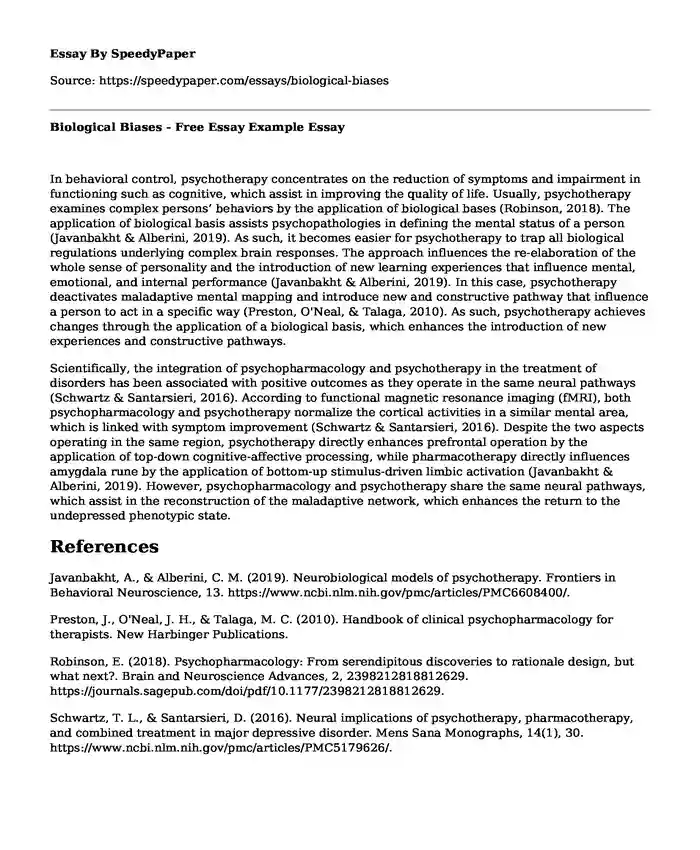
| Type of paper: | Essay |
| Categories: | Psychology Biology Anatomy Behavior |
| Pages: | 2 |
| Wordcount: | 362 words |
In behavioral control, psychotherapy concentrates on the reduction of symptoms and impairment in functioning such as cognitive, which assist in improving the quality of life. Usually, psychotherapy examines complex persons’ behaviors by the application of biological bases (Robinson, 2018). The application of biological basis assists psychopathologies in defining the mental status of a person (Javanbakht & Alberini, 2019). As such, it becomes easier for psychotherapy to trap all biological regulations underlying complex brain responses. The approach influences the re-elaboration of the whole sense of personality and the introduction of new learning experiences that influence mental, emotional, and internal performance (Javanbakht & Alberini, 2019). In this case, psychotherapy deactivates maladaptive mental mapping and introduce new and constructive pathway that influence a person to act in a specific way (Preston, O'Neal, & Talaga, 2010). As such, psychotherapy achieves changes through the application of a biological basis, which enhances the introduction of new experiences and constructive pathways.
Scientifically, the integration of psychopharmacology and psychotherapy in the treatment of disorders has been associated with positive outcomes as they operate in the same neural pathways (Schwartz & Santarsieri, 2016). According to functional magnetic resonance imaging (fMRI), both psychopharmacology and psychotherapy normalize the cortical activities in a similar mental area, which is linked with symptom improvement (Schwartz & Santarsieri, 2016). Despite the two aspects operating in the same region, psychotherapy directly enhances prefrontal operation by the application of top-down cognitive-affective processing, while pharmacotherapy directly influences amygdala rune by the application of bottom-up stimulus-driven limbic activation (Javanbakht & Alberini, 2019). However, psychopharmacology and psychotherapy share the same neural pathways, which assist in the reconstruction of the maladaptive network, which enhances the return to the undepressed phenotypic state.
References
Javanbakht, A., & Alberini, C. M. (2019). Neurobiological models of psychotherapy. Frontiers in Behavioral Neuroscience, 13. https://www.ncbi.nlm.nih.gov/pmc/articles/PMC6608400/.
Preston, J., O'Neal, J. H., & Talaga, M. C. (2010). Handbook of clinical psychopharmacology for therapists. New Harbinger Publications.
Robinson, E. (2018). Psychopharmacology: From serendipitous discoveries to rationale design, but what next?. Brain and Neuroscience Advances, 2, 2398212818812629. https://journals.sagepub.com/doi/pdf/10.1177/2398212818812629.
Schwartz, T. L., & Santarsieri, D. (2016). Neural implications of psychotherapy, pharmacotherapy, and combined treatment in major depressive disorder. Mens Sana Monographs, 14(1), 30. https://www.ncbi.nlm.nih.gov/pmc/articles/PMC5179626/.
Cite this page
Biological Biases - Free Essay Example. (2023, Aug 20). Retrieved from https://speedypaper.com/essays/biological-biases
Request Removal
If you are the original author of this essay and no longer wish to have it published on the SpeedyPaper website, please click below to request its removal:
- Assessment of Psychology and Mental Health Reactions to Traumatic Stress, Essay Example
- Critical Analysis Essay Example: Dynamic Self-Concept
- Essay Example on Exploring Ethical Behavior and Integrity in Pearson Company
- Essay Example: Project Management - Team Building
- Essay Sample on Love Stories
- Essay Sample on Obama: Reducing Carbon Emissions in US Power Plants
- Enterprise Data Mgmt: Enhancing Business Ops & Profitability - Essay Sample
Popular categories




